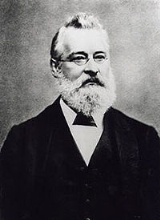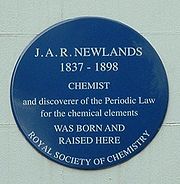
John Alexander Reina Newlands
Encyclopedia

Periodic table
The periodic table of the chemical elements is a tabular display of the 118 known chemical elements organized by selected properties of their atomic structures. Elements are presented by increasing atomic number, the number of protons in an atom's atomic nucleus...
.
Newlands was born in London
London
London is the capital city of :England and the :United Kingdom, the largest metropolitan area in the United Kingdom, and the largest urban zone in the European Union by most measures. Located on the River Thames, London has been a major settlement for two millennia, its history going back to its...
and was the son of a scottish Presbyterian minister and his Italian wife.
He was home schooled by his father rather than going to a normal school studied and went on to study at the Royal College of Chemistry
Royal College of Chemistry
The Royal College of Chemistry was a college originally based on Oxford Street in central London, England. It operated between 1845 and 1872....
but was also interested in social reform, and in 1860, he served as a volunteer with Giuseppe Garibaldi
Giuseppe Garibaldi
Giuseppe Garibaldi was an Italian military and political figure. In his twenties, he joined the Carbonari Italian patriot revolutionaries, and fled Italy after a failed insurrection. Garibaldi took part in the War of the Farrapos and the Uruguayan Civil War leading the Italian Legion, and...
in his campaign to unify Italy
Italy
Italy , officially the Italian Republic languages]] under the European Charter for Regional or Minority Languages. In each of these, Italy's official name is as follows:;;;;;;;;), is a unitary parliamentary republic in South-Central Europe. To the north it borders France, Switzerland, Austria and...
. Returning to London, he set up in practice as an analytical chemist in 1864, and in 1868 became chief chemist in James Duncan's London sugar refinery
Sugar refinery
A sugar refinery is a factory which refines raw sugar.Many cane sugar mills produce raw sugar, i.e. sugar with more colour and therefore more impurities than the white sugar which is normally consumed in households and used as an ingredient in soft drinks, cookies and so forth...
, where he introduced a number of improvements in processing. Later he left the refinery and again set up as an analyst with his brother Benjamin.
Newlands was the first person to devise a Periodic Table
Periodic table
The periodic table of the chemical elements is a tabular display of the 118 known chemical elements organized by selected properties of their atomic structures. Elements are presented by increasing atomic number, the number of protons in an atom's atomic nucleus...
of elements arranged in order of their relative atomic weights. Continuing Döbereiner
Johann Wolfgang Döbereiner
Johann Wolfgang Döbereiner was a German chemist who is best known for work that foreshadowed the periodic law for the chemical elements.- Life and work :...
’s work with triads and J. B. Dumas' families of similar elements, in 1865 he published his law of octaves which states that "any given element will exhibit analogues behaviour to the eighth element following it in the table". Newlands’ arrangement showed all known elements arranged in seven groups which he likened to the octaves of music
Octave
In music, an octave is the interval between one musical pitch and another with half or double its frequency. The octave relationship is a natural phenomenon that has been referred to as the "basic miracle of music", the use of which is "common in most musical systems"...
. The elements are ordered by atomic weights that were known at the time. They were numbered sequentially to show the order of atomic weights. In Newlands’ table periods and groups are shown going down and across the table, respectively – the opposite from the modern periodic table.
The incompleteness of a table he drew up in 1864 alluded to the possible existence of additional, undiscovered elements. For example, he predicted the existence of germanium
Germanium
Germanium is a chemical element with the symbol Ge and atomic number 32. It is a lustrous, hard, grayish-white metalloid in the carbon group, chemically similar to its group neighbors tin and silicon. The isolated element is a semiconductor, with an appearance most similar to elemental silicon....
.
At the time, his law of octaves was ridiculed by his contemporaries and the Society of Chemists did not accept his work for publication.
In 1894, Newlands had a child by the name of Christopher Maddocks Newlands.

Julius Lothar Meyer
Julius Lothar von Meyer was a German chemist. He was contemporary and competitor of Dmitri Mendeleev to draw up the first periodic table of chemical elements...
received the Davy Medal
Davy Medal
The Davy Medal is awarded by the Royal Society of London "for an outstandingly important recent discovery in any branch of chemistry". Named after Humphry Davy, the medal is awarded with a gift of £1000. The medal was first awarded in 1877 to Robert Wilhelm Bunsen and Gustav Robert Kirchhoff "for...
from the Royal Society
Royal Society
The Royal Society of London for Improving Natural Knowledge, known simply as the Royal Society, is a learned society for science, and is possibly the oldest such society in existence. Founded in November 1660, it was granted a Royal Charter by King Charles II as the "Royal Society of London"...
for their later 'discovery' of the Periodic Table, Newlands fought for recognition of his earlier work; he eventually received the Davy medal in 1887.
Newlands died on 29 July 1898 at his home in Lower Clapton
Lower Clapton
Lower Clapton is a district within the London Borough of Hackney.It is immediately adjacent to central Hackney - bounded, roughly, by the western side of Hackney Downs , the Lea Valley , Clifden Road and the Lea Bridge Road...
, London, and was buried at West Norwood Cemetery
West Norwood Cemetery
West Norwood Cemetery is a cemetery in West Norwood in London, England. It was also known as the South Metropolitan Cemetery.One of the first private landscaped cemeteries in London, it is one of the Magnificent Seven cemeteries of London, and is a site of major historical, architectural and...
. His business was continued after his death by his younger brother, Benjamin Edward Reina Newlands (1842–1912).

